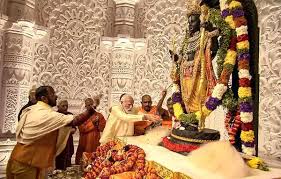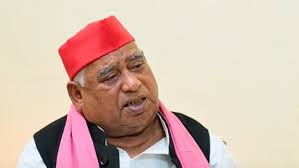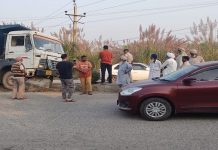Though consecration of Ram Temple in Ayodhya marked a pivotal moment for the BJP, the party quickly realized its fickle nature when it suffered a stunning reversal in the Lok Sabha elections. The state continues to face challenges on the law and order and economic fronts. A report by Mudit Mathur

The consecration of the Ram Temple bolstered the Bharatiya Janata Party’s (BJP) position in national politics, reinforcing its narrative of cultural nationalism and Hindutva. This central political strategy helped the BJP consolidate its support base, particularly among Hindu voters in northern India. The event, held in Ayodhya, carried significant political implications, symbolising a major victory for the BJP’s long-standing agenda. The event has been a focal point for the BJP and its supporters, symbolising a significant triumph for its enduring agenda.
However, despite the symbolic weight of the consecration, the BJP faced challenges in retaining its previous success in Uttar Pradesh during the Lok Sabha elections. Economic concerns, caste dynamics, and local sentiments proved critical in influencing voter behaviour, leading to an electoral setback for the party in the state.
It is true that for most, the consecration represented the fulfilment of a long-standing wish and evoked a sense of cultural and religious pride, which further solidified support for the BJP among Hindu voters who view the party as the custodian of their cultural and religious identity. At the same time, the event has polarised the electorate, sharpening divisions over religious and cultural issues.
Despite the symbolic importance of the Ram Temple, economic issues such as unemployment and rising prices overshadowed the temple’s inauguration. Many voters felt the BJP was not addressing their immediate economic concerns. While the BJP secured 33 seats in Uttar Pradesh, the national spotlight fell on its shocking defeat in the Faizabad Lok Sabha constituency, the site of the Ram Temple’s consecration.

Opposition parties, particularly the Samajwadi Party (SP), managed to present a united front and effectively countered the BJP’s narrative. By focusing on local issues and caste-based politics, they struck a chord with a large section of the electorate.
Among rural voters, there was a growing sentiment that the BJP was prioritising the development of the temple town at the expense of addressing their pressing concerns. The SP successfully highlighted how big businesses benefited from the temple’s construction, while small traders and youth bore the brunt of reckless demolition drives for beautification and road-widening projects in the temple town of Ayodhya, often carried out without rehabilitating the affected residents.
Law and order
The crime rate in Uttar Pradesh remains disproportionately high, particularly in cases involving crimes against women and children. Factors such as population density, socio-economic conditions, and fragmented law enforcement contribute to the state’s troubling crime profile. Additionally, concerns about underreporting, political influence, and resource limitations exacerbate the situation.
The Uttar Pradesh Police (UPP) faces criticism for inefficiency and alleged misuse of power. Issues such as police corruption, fake encounters, and custodial or extrajudicial killings continue to plague the system. Allegations that the police have targeted specific communities or exploited political patronage for personal gain have further eroded public trust.
The UP Police’s Special Task Force (STF), often responsible for tackling gang violence and criminal syndicates, has faced accusations of heavy-handed tactics. Both state and national Human Rights Commissions have repeatedly flagged concerns about custodial deaths, extrajudicial killings, police brutality during protests staged by residents and various organizations, and the excessive use of force, particularly in the context of anti-protest measures and criminal encounters.
Despite apex court directives, the Yogi Adityanath-led government continues to face accusations of unilateral demolitions in the wake of communal violence, where homes and businesses of those allegedly involved in riots were razed in the name of delivering instant justice. In 2024, such demolitions persisted in districts like Prayagraj, Kanpur, Sambhal, and Saharanpur, raising concerns about human rights violations and the absence of due legal process. Incidents like the 2024 Bulandshahr riots have further ignited debates over the role of political rhetoric in exacerbating communal tensions.
According to the National Crime Records Bureau (NCRB) 2023, Uttar Pradesh reported over 550,000 criminal cases, making it the state with the highest crime rate in India. Crimes against women, violent crimes, and property crimes remain significant concerns. UP accounted for 25% of India’s total crimes against women in 2023, including rape, domestic violence, and dowry-related deaths. Notably, rape cases in the state increased by 10% over the last two years, with more than 5,000 reported in 2023 alone.
The state has also witnessed an alarming rise in crimes against children, including child trafficking and sexual assault, contributing significantly to the national figures for such crimes. The NCRB 2023 reported nearly 1,500 cases of child sexual abuse in Uttar Pradesh. Additionally, the state recorded an average of 1,200 murders annually, reflecting high levels of gang violence, family feuds, and political rivalries.
The state continues to be a hotspot for violent crimes such as land-related disputes and honour killings, particularly in rural areas. It has also witnessed a high incidence of robberies, burglaries, and motor vehicle thefts, with urban centres like Lucknow, Kanpur, Gautam Budh Nagar, and Varanasi being particularly vulnerable to property crimes.
Uttar Pradesh has one of the highest pendency rates in India’s judicial system, with over four million cases awaiting resolution in its courts. This backlog severely hampers the delivery of justice, prolonging criminal trials and leaving many victims in a state of uncertainty.
The criminal justice system in Uttar Pradesh is plagued by systemic issues, including inefficiency, corruption, and overwhelming delays. The slow pace of justice, coupled with ineffective policing strategies, undermines deterrence against crime. Despite some reforms, the lack of substantial progress in law enforcement and judicial processes remains a pressing challenge.
Economy and development
On the economic front, Uttar Pradesh has made strides in improving its infrastructure, with much of the growth concentrated in urban areas and the industrial sector. Significant investments have been made in projects such as expressways, industrial hubs, and boosting the manufacturing sector. However, this progress has yet to translate into equitable development across rural regions, where agriculture-based employment continues to face challenges. The state government has emphasised on creating an investment-friendly environment through initiatives like the “UP Investor Summit” to attract both domestic and international investments.
Despite this, Uttar Pradesh remains heavily reliant on agriculture, which employs a large portion of its population. The agricultural growth has been uneven, with farmers grappling with inadequate irrigation, weather-related adversities, and high input costs. While government schemes like the “Kisan Samman Nidhi” provide some support, they fall short of addressing the underlying agrarian distress.
Unemployment remains a pressing issue, particularly among the youth. Although the state has pledged job creation in sectors such as electronics and textiles, outcomes have yet to meet expectations. The informal sector continues to dominate employment but offers little security for workers. Migration from rural areas to cities and states like Delhi and Maharashtra persists, driven by unemployment, underdevelopment, and inadequate rural infrastructure.
Social tensions in Uttar Pradesh risk intensifying unless sustained efforts are made towards reconciliation through policies that bridge divides. There is also an urgent need for improved implementation of women’s rights and protection laws. Addressing the rural-urban divide will require increased attention to rural development, focusing on health, employment and infrastructure.
As 2024 concludes, Uttar Pradesh reflects both India’s broader challenges and its immense potential. While the state has witnessed notable advancements across political, social, economic, and educational spheres, it continues to grapple with the structural and systemic issues outlined above.













